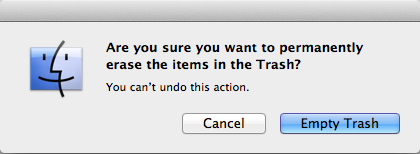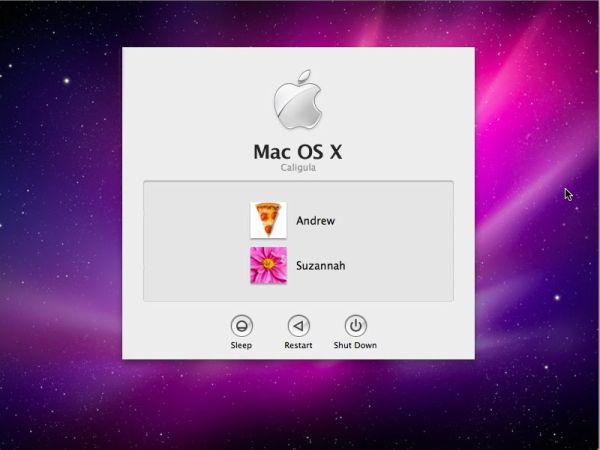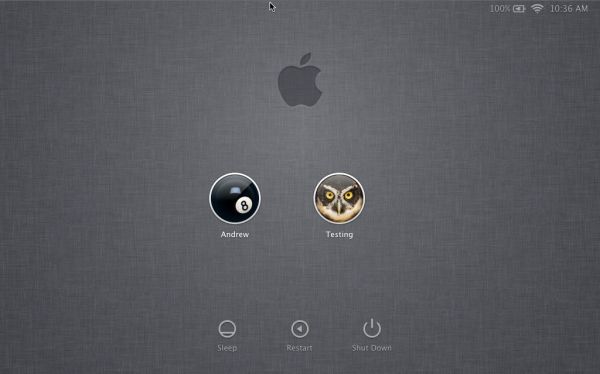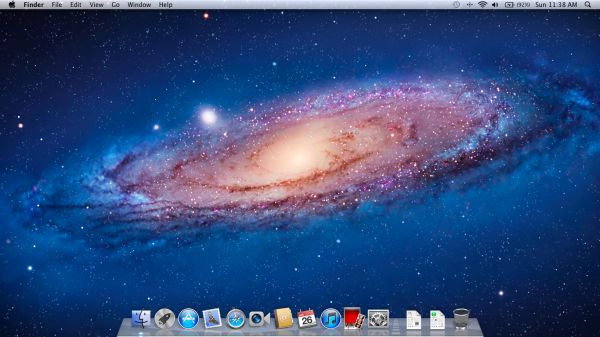Back to the Mac: OS X 10.7 Lion Review
by Andrew Cunningham, Kristian Vättö & Anand Lal Shimpi on July 20, 2011 8:30 AM ESTAll OS X versions, even the “no new features” Snow Leopard release, have made some changes to the way things look without much affecting how they act, and Lion is no exception to this.
The first (and perhaps most obvious) change is to the login screen itself. In all previous OS X versions, this has taken the form of a white box with the OS’s default wallpaper as a backdrop, with either a vertically-aligned list of users or a pair of fields where you enter your username and password (depending on the number of users on your Mac and the way you’ve configured your login screen to work).
In Lion, this has been exchanged for a simpler-looking horizontally-aligned list of users against an iOS-like textured background (again, depending on your login screen’s setup).
The login screen is marginally more useful in Lion, since you can see your computer’s wireless status, battery life, and clock in the upper-right hand corner without logging in.
This information is also shown on the lock screen, which has also been changed – it’s easier to show than to tell, as you’ll see below – and this makes it that much easier to check your Mac’s battery status without having to authenticate.
Login, and your desktop now fades into view in an iOS-esque way. In fact, Lion has a good bit more fading and zooming than Snow Leopard - most notification messages now employ some graphical razzle-dazzle and jump out at you instead of just appearing, which you’ll either think looks slick or frivolous, depending on the kind of user you are.
Fading, sliding, and zooming aside, the desktop looks pretty much identical to Snow Leopard’s, with the exception of yet another space-themed default wallpaper - The Dock and the taskbar look and act the same way as they did in the previous OS X version. One behavioral difference: windows throughout the OS can now be resized by clicking and dragging any corner of the window - this is one of those oh-wow-is-this-seriously-only-happening-now features that should have been in the OS ages ago, but that makes it no less welcome now that it’s finally here.
Apple continues its quest to get stuff off of your desktop by default – inserted discs and external drives no longer show up on the desktop by default (mounted network drives stopped showing up on the desktop by default in 10.5, and the computer’s internal hard drive stopped showing up by default in 10.6). You can switch all of this back on in the Finder’s preferences, just as before, but it’s another baby step away from an easily visible file system.
Lion also continues Apple’s slow shuffle away from the Aqua styling that defined the OS when it was originally released. For starters, the subtler, more staid icons that have been creeping in since Leopard have replaced the colorful icons in the left-hand sidebar.


Snow Leopard sidebar (left) vs. Lion sidebar (right)
The scrollbars have also been changed, depending on what you’re using for input. If you’re using a multitouch-enabled device like the Magic Trackpad (or the large glass trackpads on most MacBooks from late 2008 onward), you’ll see scrollbars only as you actually scroll – they appear and disappear as they do in iOS. However, using an older-model trackpad or traditional keyboard and mouse will cause more standard, always-present scrollbars to appear.


Snow Leopard scrollbar (left) vs. Lion scrollbar (right). Lion's scrollbar will disappear if you're using a multitouch-enabled mouse or trackpad.
Next, turn your eyes to the upper left-hand corner of your window, where you’ll notice that the close-minimize-resize buttons have been reduced in size.


Snow Leopard's buttons (left) vs. Lion's smaller buttons (right).
If you then look at the rest of the window, you may notice that the color has been lightened slightly compared to Snow Leopard – this lighter color scheme occasionally threw me off, since it’s somewhat similar to a deselected window in Snow Leopard – I occasionally thought that my clicks weren’t registering because the colors weren’t quite right.
The subtle color scheme changes also extend to buttons and progress bars in the Lion, which have shed their bright Aqua-blue in favor of a less-shiny and slightly darker blue. Notice that button shapes have also moved away from the shiny, round Aqua-style to a more traditional rounded rectangle.


Snow Leopard progress bar (top) vs. Lion progress bar (bottom)


Snow Leopard buttons (top) vs. Lion buttons (bottom)
Last, let's talk branding: The AirPort status indicator in the menu bar is now labeled Wi-Fi instead of AirPort, a small but welcome step away from a sometimes-confusing moniker. Apple's wireless hardware is still called AirPort in the System Profiler, and Apple's just-refreshed routers are still called AirPort Extreme, so it's likely that the branding will stick around - it's just not as readily evident in the OS.
None of these changes are going to have much, if any, effect on how you use the OS, but they’re there and you should know about them. OS X has been shedding the old, colorful Aqua in favor of a more reserved (if a bit less distinct) Aqua UI for awhile now, and Lion continues in that direction.













106 Comments
View All Comments
GotThumbs - Wednesday, July 20, 2011 - link
Apple has recognized the money maker it has with its App Store (Or can we now call this an application store). I'm not a mac user and most likely never will be, but I have to say their business model works very well for squeezing income from every corner of their empire. The IOS app store has been a huge money maker (30% of every purchase adds up quickly) and now Apple is moving the same business model to its computers. Apple does have a tendancey to repackage and sell its products in various versions, but with the same underlying technology (develop once, repackage multiple times). True to form, all the apple fans will swarm around and gladly deposit their coin into the machine.GotThumbs - Wednesday, July 20, 2011 - link
Realistically, They should give away their OS to invite more users, who will then shop their true money maker....the app store. Kinda like a drug dealer would give the first taste for free. :-)ltcommanderdata - Wednesday, July 20, 2011 - link
Apple's CFO Peter Oppenheimer has already said they operate the App Store as a break even venture, ie. their 30% cut basically goes directly to operating expenses. Unless you believe their CFO is actually lying to investors at shareholder meetings in which case you should report this and your evidence to the SEC.GotThumbs - Wednesday, July 20, 2011 - link
$1,634,000,000 in revenue from Other Music Related Products and Services (3)(3) Includes sales from the iTunes Store, App Store, and iBookstore in addition to sales of iPod services and Apple-branded and third-party iPod accessories
Lets not be too naive.
ltcommanderdata - Wednesday, July 20, 2011 - link
The App Store no doubt generates revenue for Apple, but how much profit do they actually make?steven75 - Friday, July 22, 2011 - link
Please educate yourself. As much as you might think it, yuo aren't smarter than the SEC.GotThumbs - Wednesday, July 20, 2011 - link
I think ALL investors are looking for profits, and if Apple happens to turn a profit through their iTunes store (whoops), do you really think the investors will be angry about the white lie?Taft12 - Wednesday, July 20, 2011 - link
Accountants can paint a revenue picture to look any way they want it to. Look no further than "Hollywood Accounting" in the movie industry. Don't take that break even comment at face value.parlour - Monday, July 25, 2011 - link
I would call up the SEC and tell them about your great insight. If what you are saying is true Apple is in deep, deep trouble.In reality it would be stupid for Apple’s CFO to lie about something like that, not worth the trouble at all.
Puppies04 - Wednesday, July 20, 2011 - link
$1,634,000,000 just to break even! Sheesh that is some massive overhead.